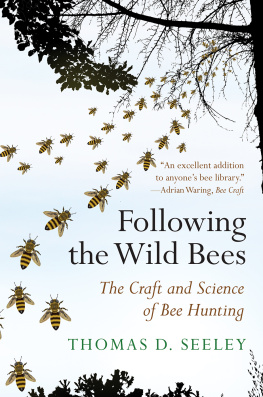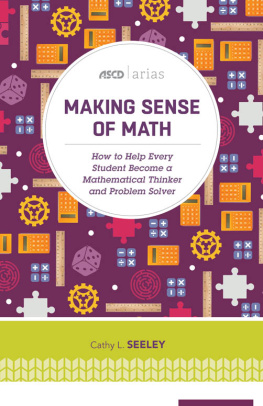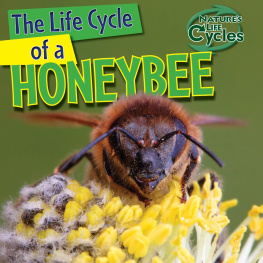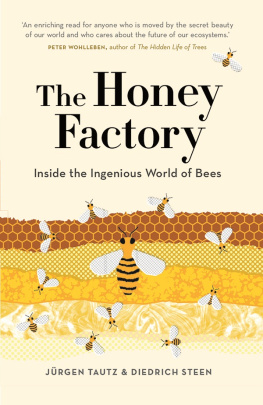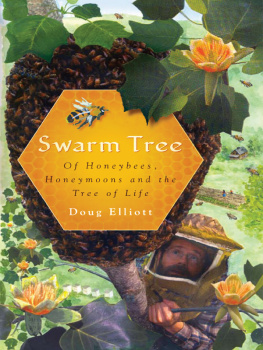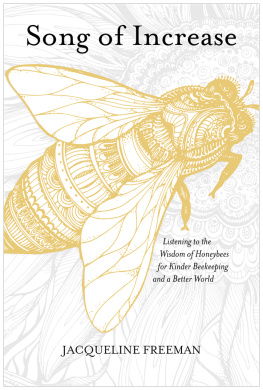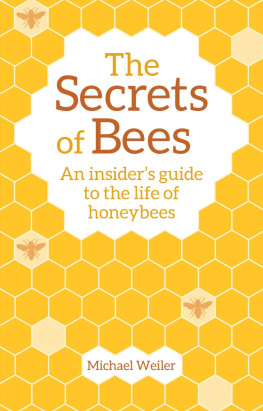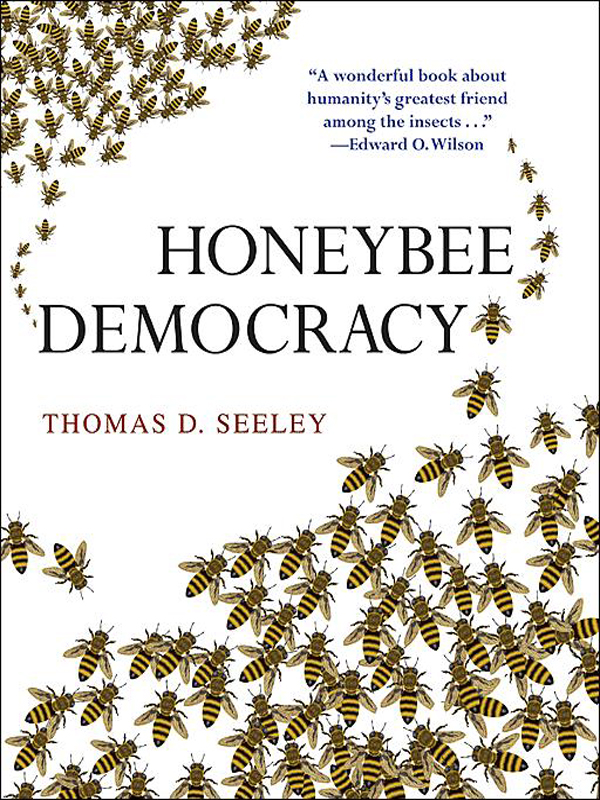Seeley, Thomas D.
Honeybee democracy /Thomas D. Seeley.
p. cm.
Includes bibliographical references and index.
ISBN 978-0-691-14721-5 (alk. paper)
1. HoneybeeBehavior. 2. insect societies. I. Title.
Printed on acid-free paper.
PROLOGUE
B eekeepers have long observed, and lamented, the tendency of their hives to swarm in the late spring and early summer. When this happens, the majority of a colonys membersa crowd of some ten thousand worker beesfies of with the old queen to produce a daughter colony, while the rest stays at home and rears a new queen to perpetuate the parental colony. The migrating bees settle on a tree branch in a beardlike cluster and then hang there together for several hours or a few days. During this time, these homeless insects will do something truly amazing; they will hold a democratic debate to choose their new home.
This book is about how honeybees conduct this democratic decision-making process. We will examine the way that several hundred of a swarms oldest bees spring into action as nest-site scouts and begin exploring the countryside for dark crevices. We will see how these house hunters evaluate the potential dwelling places they find; advertise their discoveries to their fellow scouts with lively dances; debate vigorously to choose the best nest site, then rouse the entire swarm to take off; and finally pilot the cloud of airborne bees to its home. This is typically a hollow tree several miles away.
My motive for writing this book about democracy in honeybee swarms is twofold. First, I want to present to biologists and social scientists a coherent summary of the research on this topic that has been conducted over the last 60 years, starting with the work of Martin Lindauer in Germany. Until now, the information on this subject has remained scattered among dozens of papers published in numerous scientific journals, which makes it hard to see how each discovery is connected to all the others. The story of how honeybees make a democratic decision based on a face-to-face, consensus-seeking assembly is certainly important to behavioral biologists interested in how social animals make group decisions.I hope it will also prove important to neuroscientists studying the neural basis of decision making, for there are intriguing similarities between honeybee swarms and primate brains in the ways that they process information to make decisions. Furthermore, I hope the story of the house-hunting bees will be helpful to social scientists in their search for ways to raise the reliability of decision making by human groups. One important lesson that we can glean from the bees in this regard is that even in a group composed of friendly individuals with common interests, conflict can be a useful element in a decision-making process. That is, it often pays a group to argue things carefully through to find the best solution to a tough problem.
My second motive for writing this book is to share with beekeepers and general readers the pleasures I have experienced in investigating swarms of honeybees. I can thank these beautiful little creatures for many hours of the purest joy of discovery, interspersed among (to be sure) days and weeks of fruitless and sometimes discouraging work. To give a sense of the excitement and challenge of studying the bees, I will report numerous personal events, speculations, and thoughts about conducting scientific studies.
The work described here rests on a solid foundation of knowledge that the late Professor Martin Lindauer (19182008) created with his studies of the househunting bees in the 1950s. I wish to dedicate this book to Martin Lindauer, my friend and teacher, whose pioneering investigations inspired my own explorations of the wonderland of the bees society.
Tom Seeley
Ithaca, New York
1
INTRODUCTION
Go to the bee,
thou poet:
consider her ways
and be wise.
George Bernard Shaw, Man and Superman, 1903
H oneybees are sweetness and lightproducers of honey and beeswaxso it is no great wonder that humans have prized these small creatures since ancient times. Even today, when rich sweets and bright lights are commonplace, we humans continue to treasure these hard-working insects, especially the 200 billion or so that live in partnership with commercial beekeepers and perform on our behalf a critical agricultural mission: go forth and pollinate. In North America, the managed honeybees are the primary pollinators for some 50 fruit and vegetable crops, which together form the most nutritious portion of our daily diet. But honeybees also provide us another great gift, one that feeds our brains rather than our bellies, for inside each teeming beehive is an exemplar of a community whose members succeed in working together to achieve shared goals. We will see that these little six-legged beauties have something to teach us about building smoothly functioning groups, especially ones capable of exploiting fully the power of democratic decision making.
Our lessons will come from just one species of honeybee, Apis mellifera, the best-known insect on the planet. Originally native to western Asia, the). We can see it further in their harmonious societies, wherein tens of thousands of worker bees, through enlightened self-interest, cooperate to serve a colonys common good. And in this book, we will see the social beauty of honeybees vividly, and in fine detail, by examining how a colony achieves near-perfect accuracy when it selects its home.

Choosing the right dwelling place is a life-or-death matter for a honeybee colony. If a colony chooses poorly, and so occupies a nest cavity that is too small to hold the honey stores it needs to survive winter, or that provides it with poor protection from cold winds and hungry marauders, then it will die. Given the vital importance of choosing a suitably roomy and snug homesite, it is notsurprising that a colonys choice of its living quarters is made not by a few bees acting alone but by several hundred bees acting collectively. This book is about how this sizable search committee almost always makes a good choice. We will uncover the means by which these house-hunting bees scour the neighborhood for potential nest sites, report the news of their discoveries, conduct a frank debate about these options, and ultimately reach an agreement about which site will be their colonys new dwelling place. In short, we will examine the ingenious workings of honeybee democracy.
There is one common misunderstanding about the inner operations of a honeybee colony that I must dispel at the outset, namely that a colony is governed by a benevolent dictator, Her Majesty the Queen. The belief that a colonys coherence derives from an omniscient queen (or king) telling the workers what to do is centuries old, tracing back to Aristotle and persisting until modern times. But it is false. What is true is that a colonys queen lies at the heart of the whole operation, for a honeybee colony is an immense family consisting of the mother queen and her thousands of progeny. It is also true that the many thousands of attentive daughters (the workers) of the mother queen are, ultimately, all striving to promote her survival and reproduction. Nevertheless, a colonys queen is not the Royal Decider. Rather, she is the Royal Ovipositer. Each summer day, she monotonously lays the 1,500 or so eggs needed to maintain her colonys workforce. She is oblivious of her colonys ever-changing labor needsfor example, more comb builders here, fewer pollen foragers thereto which the colonys staff of worker bees steadily adapts itself. The only known dominion exercised by the queen is the suppression of rearing additional queens. She accomplishes this with a glandular secretion, called queen substance, that workers contacting her pick up on their antennae and distribute to all corners of the hive. In this way, these workers spread the word that their mother queen is alive and well, hence there is no need to rear a new queen. So the mother queen is not the workers boss. Indeed, there is no all-knowing central planner supervising the thousands and thousands of worker bees in a colony. The work of a hive is instead governed collectively by the workers themselves, each one an alert individual making tours of inspection looking for things to do and acting on her own to serve the community. Living close together, connected by the network of their sharedenvironment and a repertoire of signals for informing one another of urgent labor needsfor example, dances that direct foragers to flowers brimming with sweet nectarthe workers achieve an enviable harmony of labor without supervision.


